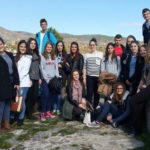An example from German-Czech history shows how difficult it can still be today to produce a collective narrative for the European commemorative culture.
By Hannah Illing / 5.7.2017
How can Europe “bring its citizens closer together again”? Currently, this question is frequently posed, be it from the European Institutions, the German Federal Government or European intellectuals, that it almost seems a little trite. At least since Pulse of Europe it is clear that Europe’s citizens can very well identify with the European Union, and that elite discussions in Brussels conference rooms are not required for this identification.
When it comes to identifying with Europe, the Second World War is often cited as the “founding myth”, representing Europe as a peace project. What is difficult, is that the Second World War has different associations in various European countries. The Czech population was suffering from the Nazi’s brutal tyranny: the so-called “Protectorate of Bohemia and Moravia” was characterised by abduction, forced labour and the murder of Czech citizens. In 1942, after the assassination of the “Reich protector”, Reinhard Heydrich, by Czech resistance fighters, terrible retaliation measures followed. Thus the Nazis destroyed, among other things, the two villages of Lidice and Ležáky, almost all of the inhabitants were murdered (including children and young people). Suddenly, after the Second World War, the German population in Czechoslovakia, the Sudeten Germans, saw themselves in the role of the victim. The majority of them – about three million people – had to leave their homeland, and the expulsion involved a few massacres. The catalyst was the so-called Beneš Decrees, which ordered the expatriation and expropriation of the Sudeten Germans.
Undoubtedly, the expulsion of the Sudeten Germans seems almost innocuous in comparison to the German occupation and the atrocities of the Nazis. But if there is sacrifice even on the perpetrator’s side, a common European commemorative culture will be much more complicated. Can a common narrative of European history be created without reconciliation? And does the suffering become ruled out over time, does it become irrelevant to the descendants of perpetrators and victims?

An installation by the Czech sculptor Josefína Jonášová was shown at the reconciliation concert organised by the citizens’ initiative “Smíření (Reconciliation) 2016” in Prague last autumn – a peace dove. © Smíření 2016
At a Young European Federalists (JEF) Prague meeting a few weeks ago, a Prague politician, Vladka Jelinková, presented her initiative “Smíření (Reconciliation) 2016”, a good example of a cross-border European project which contributes to the process of coming to terms with the displacement of the Sudeten Germans. Initiator Jelinkovà studied with the Erasmus scholarship in Dresden, where she spoke with German expellees for the first time. Since then, she has not let go of the feeling of wanting to contribute to the reconciliation with the Sudeten Germans. In November 2016, her initiative invited more than 90 Germans to Prague – the expellees and their descendants. Among other things, a “reconciliation concert” took place in a Prague church in the same district where, before 1945, the majority of the German population in Prague lived. In the Czech Republic, since the Velvet Revolution, civil society projects have repeatedly been undertaken to deal with the expulsion, which are not supported by the majority of politicians. The Czech President, Miloš Zeman, for example, regularly uses the resentment that persists in Czech society against the Sudeten Germans in order to grab for votes.
At the meeting with JEF Prague, however, it became clear how central the Nazis reign of violence in the “Protectorate of Bohemia and Moravia” still is for young Czechs. Originally, the workup of the expulsion of the Sudeten Germans in the Czech Republic was to be discussed. In the end, however, it was about the Germans’ guilt and the ever more visible tendencies towards right-wing extremism in some parts of German society.
For the European commemorative culture, projects such as “Smíření (Reconciliation) 2016” are very important because citizens can talk about their memories together – or about the experiences of their parents and grandparents during the Second World War. The fact that this memory takes on different forms then loses its significance: together, a new narrative can be formed, which includes different perspectives. I have often heard from Brussels officials that the narrative of the peace project Europe no longer attracts young people. However, I believe that the Second World War is still an important issue in the new Member States and that it can very well serve to strengthen the identification with the European idea. Projects from civil society are a first step and can still build bridges after 70 years.
This article was first published on thenewfederalist.eu, the magazine of the Young European Federalists. The content they produce is also published in French, Spanish, German and Italian.





Recent Comments